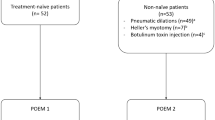Abstract
Introduction
There are only few studies about the outcomes of peroral endoscopic myotomy (POEM) for type III achalasia in a relatively large population to date. The purpose of this study was to explore the long-term efficacy of POEM for patients with type III achalasia.
Methods
There were a total of 32 consecutive patients with type III achalasia undergoing POEM in our hospital from July 2012 to October 2014. Clinical date of general characteristics, procedure-related parameters and adverse events, symptom relief, and the high-resolution manometry outcomes before and during the periodic follow-up were retrospectively collected and analyzed.
Results
All of the 32 patients underwent POEM successfully with a median operation time of 34.9 min (range 17.9–88.6 min). No serious complications related to POEM were encountered. Treatment success was achieved in 90.6% cases during a median follow-up period of 27.0 months (range 24–51 months). The mean pretreatment and post-treatment Eckardt scores were 7.2 and 1.4, respectively (P < 0.001), and mean LES pressure also decreased from a mean of 39.2 to 19.0 mmHg after the procedure (P < 0.001). Both of the gas-related complication and clinical reflux complication rates were 18.8%.
Conclusion
Our results confirm that POEM for type III achalasia of Chicago Classification is effective with a long-term symptom relief in 90.6% cases. But a further, prospective study is needed to evaluate whether POEM outcome could be correlated with manometric subtypes according to Chicago Classification.


Similar content being viewed by others
References
Boeckxstaens GE, Zaninotto G, Richter JE (2014) Achalasia. Lancet (London, England) 383:83–93
Richter JE (2010) Achalasia—an update. Journal of Neurogastroenterology and Motility 16:232–242
Familiari P, Gigante G, Marchese M, Boskoski I, Tringali A, Perri V, Costamagna G (2016) Peroral Endoscopic Myotomy for Esophageal Achalasia: Outcomes of the First 100 Patients With Short-term Follow-up. Annals of surgery 263:82–87
Pandolfino JE, Kwiatek MA, Nealis T, Bulsiewicz W, Post J, Kahrilas PJ (2008) Achalasia: a new clinically relevant classification by high-resolution manometry. Gastroenterology 135:1526–1533
Ou YH, Nie XM, Li LF, Wei ZJ, Jiang B (2016) High-resolution manometric subtypes as a predictive factor for the treatment of achalasia: A meta-analysis and systematic review. Journal of Digestive Diseases 17:222–235
Salvador R, Costantini M, Zaninotto G, Morbin T, Rizzetto C, Zanatta L, Ceolin M, Finotti E, Nicoletti L, Da Dalt G, Cavallin F, Ancona E (2010) The preoperative manometric pattern predicts the outcome of surgical treatment for esophageal achalasia. Journal of Gastrointestinal Surgery : Official Journal of the Society for Surgery of the Alimentary Tract 14:1635–1645
Rohof WO, Salvador R, Annese V, Bruley des Varannes, S, Chaussade S, Costantini M, Elizalde JI, Gaudric M, Smout AJ, Tack J, Busch OR, Zaninotto G, Boeckxstaens GE (2013) Outcomes of treatment for achalasia depend on manometric subtype. Gastroenterology 144:718–725; quiz e713-714
Pratap N, Kalapala R, Darisetty S, Joshi N, Ramchandani M, Banerjee R, Lakhtakia S, Gupta R, Tandan M, Rao GV, Reddy DN (2011) Achalasia cardia subtyping by high-resolution manometry predicts the therapeutic outcome of pneumatic balloon dilatation. Journal of Neurogastroenterology and Motility 17:48–53
Yamashita H, Ashida K, Fukuchi T, Nagatani Y, Koga H, Senda K, Eguchi T, Ubukata S, Kawaguchi S, Ueda A, Tanaka T, Ohashi R, Ito D (2013) Predictive factors associated with the success of pneumatic dilatation in Japanese patients with primary achalasia: a study using high-resolution manometry. Digestion 87:23–28
Kumbhari V, Tieu AH, Onimaru M, El Zein MH, Teitelbaum EN, Ujiki MB, Gitelis ME, Modayil RJ, Hungness ES, Stavropoulos SN, Shiwaku H, Kunda R, Chiu P, Saxena P, Messallam AA, Inoue H, Khashab MA (2015) Peroral endoscopic myotomy (POEM) vs laparoscopic Heller myotomy (LHM) for the treatment of Type III achalasia in 75 patients: a multicenter comparative study. Endoscopy international open 3:E195–201
Li HK, Linghu EQ (2013) New endoscopic classification of achalasia for selection of candidates for peroral endoscopic myotomy. World Journal of Gastroenterology 19:556–560
Shiwaku H, Inoue H, Yamashita K, Ohmiya T, Beppu R, Nakashima R, Takeno S, Sasaki T, Nimura S, Yamashita Y (2016) Peroral endoscopic myotomy for esophageal achalasia: outcomes of the first over 100 patients with short-term follow-up. Surgical endoscopy 30:4817–4826
Author information
Authors and Affiliations
Corresponding author
Ethics declarations
Conflict of Interest
The authors declare that they have no conflicts of interest.
Funding Information Specific to this Paper
There is no special financial support for the present study.
Rights and permissions
About this article
Cite this article
Zhang, W., Linghu, EQ. Peroral Endoscopic Myotomy for Type III Achalasia of Chicago Classification: Outcomes with a Minimum Follow-Up of 24 Months. J Gastrointest Surg 21, 785–791 (2017). https://doi.org/10.1007/s11605-017-3398-x
Received:
Accepted:
Published:
Issue Date:
DOI: https://doi.org/10.1007/s11605-017-3398-x




